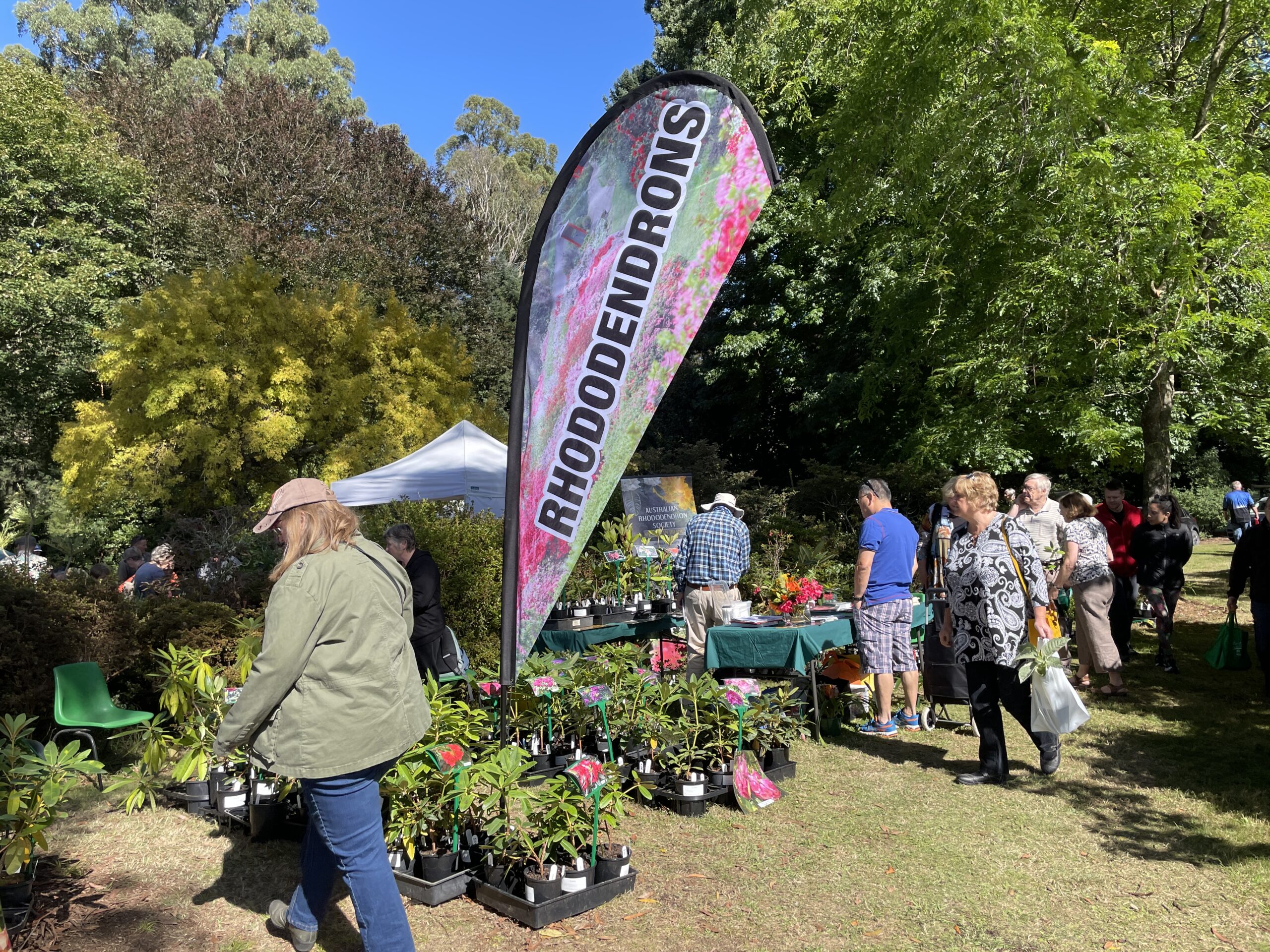Guest Article NW YUNNAN 2015 – PLANT EXPLORATION
In late May 2015 I found myself leading a group of four other intrepid amateur plant hunters on a trip to north western Yunnan - China. This particular area of China I believe has not been explored before by the regular plant hunters we are familiar with.
Before I get into the story proper there is a little background that involves NZRA. In mid-2014 the NZRA website received an enquiry from Adrian Bottomley owner of www.whistlingarrow.com a boutique adventure travel company based in Hong Kong. In his email Adrian was seeking information on anyone who may be interested in helping him identify plants, mainly Rhododendrons, on a trip he was planning to China in 2015. His email had some very enticing photos from a reconnaissance trip he had just undertaken. The only proviso was that the person had to be fit as the trip was to be an arduous one in the mountains. Graham Smith ended up with the email and forwarded it on to me as they say the rest is history.
We first flew into Kunming then flew to Baoshan, a large town in western Yunnan strategically located at the base of the Nujiang Valley. I was last in Baoshan in 1990 on Ron Gordon’s first China trip, the city is unrecognisable now due to rampant growth and development since that time.
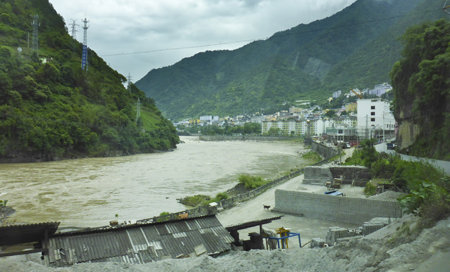
We then drove for six hours (via Liuku) to our first nights’ accommodation in a small hotel in the riverside town of Fugong. The whole journey followed up the Salween (Nu-Angry) river. The Salween is a large dirty brown river and at this altitude the temperature was in the high twenty’s and quite humid.
We drove for another seven hours up through the Nujiang Valley, via Gongshan to Bingzhongluo (1800m). En-route we passed through several small towns, with bustling markets full of Lisu and Yi who descend from nearby mountain villages to shop and trade. The road follows the Nu (or angry) River as it flows, often violently, in the opposite direction. The scenery became increasingly beautiful as the valley narrowed and the first of the regions famous (though seldom-used these days) wire bridges started to appear. Of particular interest en-route was the 'Stone Moon', a 50 metre wide, almost perfect circle eroded into the sheer rock face of the Gaoligong Mountains that form the west ridge of the valley.
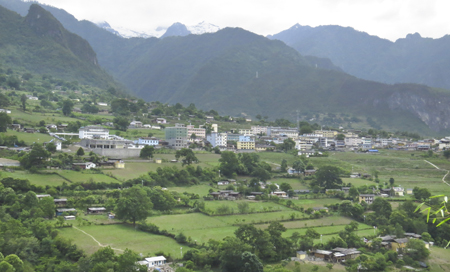
We stayed in Bingzhongluo for two nights before the trip proper and set off on a 4 hour acclimatisation hike along the Nu River and visited two Lisu villages en-route. The trail also features a section of the ancient Tea Horse Trail cut out of the sheer cliff above the raging river. This trail was still used into the 1950s.
Now for the trek proper, the party consisted of two from Australia, and one each from Germany and England and myself, plus Adrian and Edward the local Chinese guide for Whistling Arrow. Leaving Bingzhongluo we drove 7 kilometres to a small Lisu village where we will meet our nine porters. These poor guys had to carry all our belongings, food and accessories for the whole seven day trek. After some final preparations we began day one a 7-8 hour trek up through the forested valley. It was very hot and humid with a starting altitude of 2000m. There were lots of plants to stop and botanise with. Most spectacular being Rosa heleneae, a vigorous climber with creamy yellow flowers and highly scented.
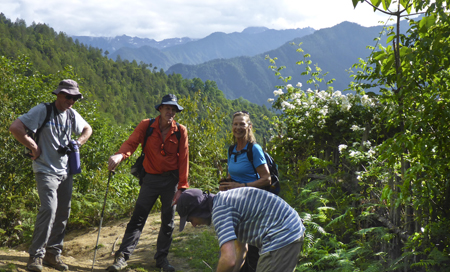
The foliage soon became all-embracing, pristine; the surroundings lacking all sign of people or cultivation. Passing Magnolia globosa, Rhododendron nuttalli and lindlyii, all epiphytic growing high up in the trees above. At ground level was a myriad of different Arisaema, Pleiones and Primula. It’s about this time I started to think I should have done more research on specific plant names!!!
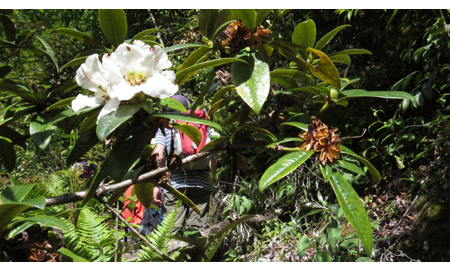
Higher up, the valley started to open up and the thick forest was replaced by scattered Picea georgii. Every corner turned highlighted the vast array of plant species that this part of China has to offer. Thankfully, the long, hard day's hiking was finally rewarded by an almost perfect setting in which we camped. A beautiful meadow carpeted with yellow Primula and surrounded by soaring peaks. The locals call this spot Da Chen Da meadow (3100m).Above us on the rocks were masses of R oreotrophes and R calostrotum. Wild horses and cattle were all around.
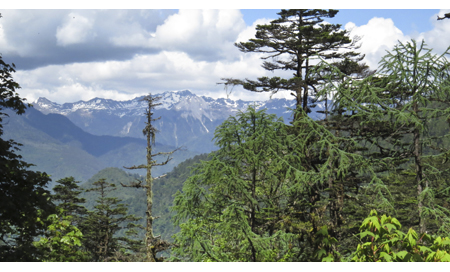
The next morning we woke to over-cast conditions with rain threatening, after such a brilliant day the day before we were a bit deflated. This deflation became worse when we discovered our kitchen tent has been destroyed by the wild horses in the night and that all our rice, vegetables and other essential ingredients had all been scoffed!
The rain now set in; luckily the day was relatively short 3 hours trek to our camp at the end of a glacial valley in a beautiful spot the locals call Gan Ji Tong or 'Ox Meadow Mountain' (3400m). Hemmed in by soaring peaks, the lush meadow has an abundance of wildflowers and is again populated by wild horses and oxen. On the way we passed huge moss-reddened boulders and thundering waterfalls cascading down the mountainside. In the far upper reaches, at the foot of a small glacier, we got our first glimpse of Rhododendron forest.
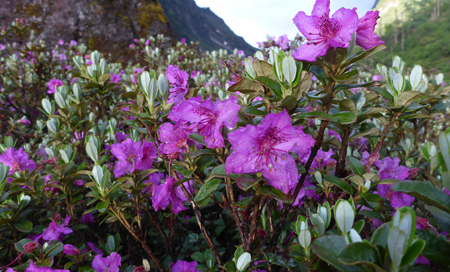
In the afternoon we explored this area which was at the foot of the huge peak that stands guard over the end of the valley. Here we discovered huge field of Primula agleniana, beautiful porcelain white and sometimes a delicate pink with a bonus of being highly scented, the scent seemed to envelop the whole valley even in the rain. In the Rhododendron line we saw R sanguineum - red and R mekongense - yellow. Both these Rhododendrons we would see for the majority of the trek but with wide variability in colour. The sanguineum from light bright red to dark claret red almost black, while R mekongense from pale yellow to dark rich yellow.
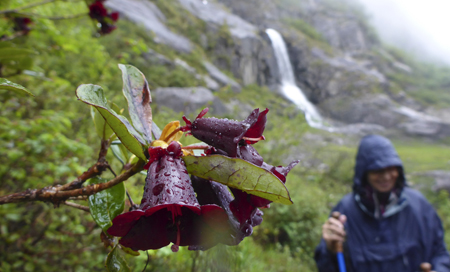
After a wet and cold night the morning saw us trek up over a ridge and into the next parallel valley. The climb up over De Lui Za (3900m) was a challenge, though ultimately rewarded by a somewhat misty but fleetingly stunning view of Mount Gaoligong. At the top of the pass we were to come across our first taste of large swaths of R forrestii var repens with typically a single red flower per plant, many poking through the snow. From our vantage point we were informed that last year for almost as far as the eye can see, huge swaths of Rhododendron bushes covering entire mountainsides grew in all directions.
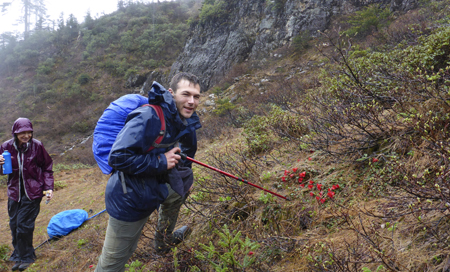
Unfortunately the cloud came in and as we started down from the pass and we encountered huge drifts of snow that in a normal year should have long ago melted. We had to trek through this for the next 3 hours with only the odd Rhododendron plant in flower. Just our luck our visit had coincided with an off year for flowering and those that were going to flower were some weeks away due to the colder spring being experienced.
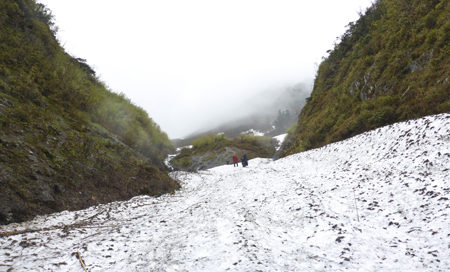
We did manage to see a wide colour palate of R neriflora group; no one was game enough to put a specific name to them. There were pinks, red and yellows. And in this area our porters busied themselves collected caterpillar pupae fungi, apparently an aphrodisiac and worth good money back down the valley. The large areas of Rhododendrons we did see were all snow affected – sort of all bent over like a glacier had run them over . Other plants we did see Included huge Picea georgii, Larix potani and Sorbus spp just coming into leaf. Two types of yet to name Primula were prevalent one had small white sessile flowers just emerging through the snow.
We followed and scrambled along Lisu hunting paths that dissect the Rhododendron fields to a 'junction' where four valleys join (3500m). Originally it was intended we would camp here but the rain had caused the river to rise quite quickly and we were lucky to get across the single log bridge with water lapping over it.
It was here our porters decided it was time for them to stop and light a fire warm up and have a meal, just how they managed to light a fire in pouring rain was a miracle but a welcome one. We too shared the fires warmth and the salty green tea while a new plan was decided upon of where we were to camp that night.
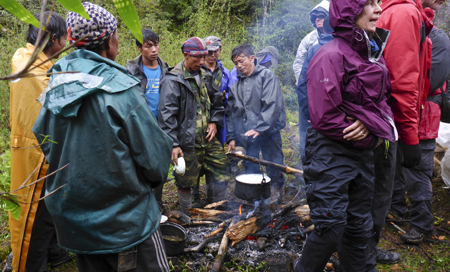
It was decided that the only feasible option was to hike up through mixed rhododendron and bamboo forest to a beautiful lake at the foot of Mt Gaoligong where we would set up camp (3850m). What had already been a long, hard day of almost 8 hours trekking in persistent rain was to last another 4 hours. We had a consistent climb back out of the valley floor to the lake – it appears this lake is not named.
Although tired and wet our spirits were lifted when we entered a prolonged upward climb through a Rhododendron forest consisting of R arizelum, glishrum, sanguineum. These plants came in very handy to assist in hauling our aching bodies up the mountain as some plants were 5 m in height. Eventually we arrived at our destination and yes the view was beautiful and we could just make out the lake through the mist, rain and failing light. With no time to loose we pitched our tents on the only dry area above the lake on top of a large area of R forrestii var repens.
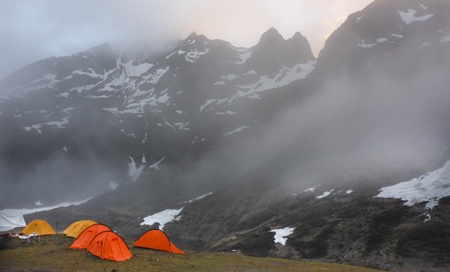
We remained at this spectacular spot for two nights. The jagged, snow-capped peaks of Mount Gaoligong stand like a sentinel above our camp but we only had glimpses of its magnificence through the persistent mist and rain. We spent our time exploring the large groves of rhododendrons that grew right around this lake. Again we didn’t strike the time right as only a few were out and these included R citiniflorum, campylocarpum, citriniflorum var horaeum, pumilum to name a few. However it was the vast areas of R forrestii var repens that stole the show – all peaking in flower just for our enjoyment.
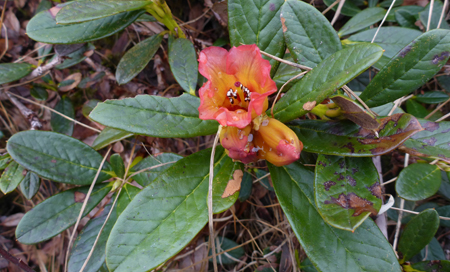
We spent most of this day drying wet clothes by the fire.
As the fog lifted a large patch of purple was spied high up above the lake – an expedition was sent to discover what species of Rhododendron it was, after an hours climb to an altitude of 4200 m it turned out to be a massive patch of Primula, species unknown. Another magnificent find was Diapensia purpurea a lovely prostrate growing rock garden plant with bowl shaped white flowers.
The following morning, we set off on a tough 4 hour hike down the Li Wa Lo valley to the next campsite. The terrain was mainly bamboo and Rhododendron forest of R arizelum, glishrum, sanguineum, sino grande, yunnanense before breaking out into fields of chest-high perennial fields. Typical plants included Arisaema,Thalictrum, Aconitum, Corydalis, Smilax and Smilacina.
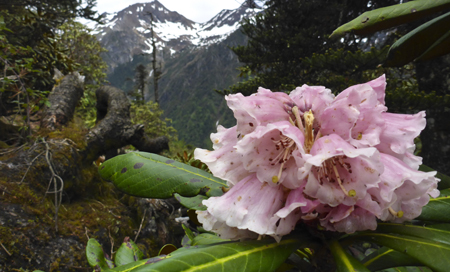
The narrow path followed the small river down past massive boulders. Here we set up camp at 3300m in amongst perennials. The scented white Smilacina was a real bonus.
Our last day saw us undertake an 8 hour hike out of the wilderness and back to civilization dropping 2000m in the process. The trail first winds its way through primordial, moss-covered forest scattered with gigantic conifers, old trees of Juniperus coxii - Chinese coffin pine and Taiwania flousiana, all 800 – 1000 years old. - Often up to three metres in diameter. The forest floor was tough going, with huge boulders and sprawling root systems that sometimes had to be traversed by tip-toeing along fallen logs. Likewise, we had to cross the river using primitive log bridges with a flimsy wire attached that offers just about enough support! Eventually we reached a road, and rendezvoused with our transport and enjoyed the scenic drive back to Bingzhongluo where the hot showers and soft bed were very welcome.
In summary this was a fantastic trip despite the weather. It wasn’t for the fainthearted or the unfit and just seeing the amazing variety of plants in the wild was awe-inspiring. This I believe is how we should see China and its plants.
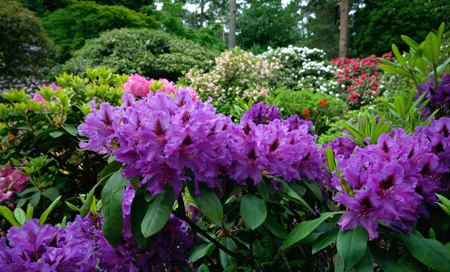
Latest Newsletters
- Emu Valley
- ARS Victoria
- Emu Valley
- ARS Victoria
